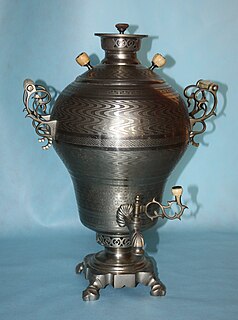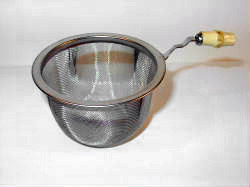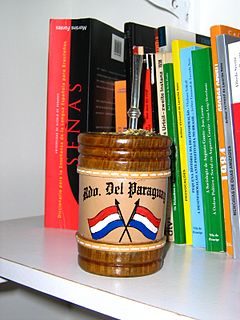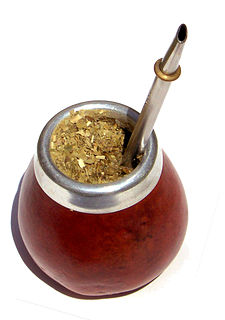
Argentine cuisine is described as a cultural blending of Mediterranean influences brought by the Spanish during the colonial period and, later, by Italian and Spanish immigrants to Argentina during 19th and 20th centuries, with influences from a further cultural blending of criollos with the Indigenous peoples of Argentina.

Spanish cuisine consists of the cooking traditions and practices from Spain. Olive oil is heavily used in Spanish cuisine. It forms the base of many vegetable sauces. Herbs most commonly-used include parsley, oregano, rosemary and thyme. The use of garlic has been noted as "common to all Spanish cooking." The most used meats in Spanish cuisine include chicken, pork, lamb and veal. Fish and seafood are also consumed on a regular basis.

Yerba mate or yerba-maté, from Spanish [ˈʝeɾβa ˈmate]; Portuguese: erva-mate, [ˈɛɾvɐ ˈmate] or [ˈɛɾvɐ ˈmatʃɪ]; Guarani: ka'a, IPA: [kaʔa], is a plant species of the holly genus Ilex native to South America. It was named by the French botanist Augustin Saint-Hilaire.

A teapot is a vessel used for steeping tea leaves or a herbal mix in boiling or near-boiling water, and for serving the resulting infusion which is called tea. Dry tea is available either in tea bags or as loose tea, in which case a tea infuser or tea strainer may be of some assistance, either to hold the leaves as they steep or to catch the leaves inside the teapot when the tea is poured. Teapots usually have an opening with a lid at their top, where the dry tea and hot water are added, a handle for holding by hand and a spout through which the tea is served. Some teapots have a strainer built-in on the inner edge of the spout. A small air hole in the lid is often created to stop the spout from dripping and splashing when tea is poured. In modern times, a thermally insulating cover called a tea cosy may be used to enhance the steeping process or to prevent the contents of the teapot from cooling too rapidly.

Cookware and bakeware are food preparation vessels used in kitchens. Cookware is used on a stove or range cooktop, while bakeware is used in an oven. Some utensils are considered both cookware and bakeware.

A samovar is a metal container traditionally used to heat and boil water. Although originating in Russia, the samovar is well known outside of Russia and has spread through Russian culture to Eastern Europe, South-Eastern Europe, Iran, Afghanistan, the Kashmir region of India, the Middle East, Azerbaijan and is also known in some parts of Central Europe. Since the heated water is typically used to make tea, many samovars have a ring-shaped attachment around the chimney to hold and heat a teapot filled with tea concentrate. Though traditionally heated with coal or kindling, many newer samovars use electricity to heat water in a manner similar to an electric water boiler. Antique samovars are often prized for their beautiful workmanship.

A colander is a kitchen utensil used to strain foods such as pasta or to rinse vegetables. The perforated nature of the colander allows liquid to drain through while retaining the solids inside. It is sometimes also called a pasta strainer or kitchen sieve.

A tea strainer is a type of strainer that is placed over or in a teacup to catch loose tea leaves.

Calabash, also known as bottle gourd, white-flowered gourd, long melon, New Guinea bean and Tasmania bean, is a vine grown for its fruit. It can be either harvested young to be consumed as a vegetable, or harvested mature to be dried and used as a utensil. When it is fresh, the fruit has a light green smooth skin and white flesh.

Tereré or Terere is an infusion of yerba mate, similar to mate but prepared with cold water and ice rather than with hot water, and in a slightly larger vessel. This infusion has its roots in Pre-Columbian America, which established itself as traditional in the Guaranitic region during the time of Guaraní-Jesuit Missions, just as the Jesuit chronicles of the 17th and 18th centuries give certainty.

Mate or maté also known as chimarrão or cimarrón, is a traditional South American caffeine-rich infused drink. It is made by soaking dried leaves of the holly species Ilex paraguariensis in hot water and is served with a metal straw in a container typically made from a calabash gourd.

The Diccionario de la lengua española is a dictionary of the Spanish language. Previously known as Diccionario de la Real Academia Española, it is produced, edited, and published by the Real Academia Española with participation of the Asociación de Academias de la Lengua Española. It was first published in 1780, and subsequent editions have been published about once a decade. The twenty-third edition was published in 2014.

Salakót is a traditional lightweight headgear from the Philippines used for protection against the sun and rain. They are usually dome-shaped or cone-shaped and can range in size from having very wide brims to being almost helmet-like. They are made from various materials including bamboo, rattan, nito ferns, and bottle gourd. The tip of the crown commonly has a spiked or knobbed finial made of metal or wood. It is held in place by an inner headband and a chinstrap. Salakot is also spelled as salacot in Spanish and salacco in French. It is the direct precursor to the pith helmet widely used by European military forces in the colonial era.

Uruguayan cuisine is a fusion of cuisines from several European countries, especially from Mediterranean foods from Spain, Italy, Portugal and France. Other influences on the cuisine resulted from immigration from countries such as Germany and Scotland. Uruguayan gastronomy is a result of immigration, rather than local Amerindian cuisine, because the new colonies did not trust the native Charrúa people. Spanish influences are very abundant: desserts like churros, flan, ensaimadas yoo (Catalan sweet bread), and alfajores were all brought from Spain. There are also all kinds of stews known as guisos or estofados, arroces, and fabada. All of the guisos and traditional pucheros (stews) are also of Spanish origin. Uruguayan preparations of fish, such as dried salt cod (bacalao), calamari, and octopus, originate from the Basque and Galician regions, and also Portugal. Due to its strong Italian tradition, all of the famous Italian pasta dishes are present in Uruguay including ravioli, lasagne, tortellini, fettuccine, and the traditional gnocchi. Although the pasta can be served with many sauces, there is one special sauce that was created by Uruguayans. Caruso sauce is a pasta sauce made from double cream, meat, onions, ham and mushrooms. It is very popular with sorrentinos and agnolotti. Additionally, there is Germanic influence in Uruguayan cuisine as well, particularly in sweet dishes. The pastries known as bizcochos are Germanic in origin: croissants, known as medialunas, are the most popular of these, and can be found in two varieties: butter- and lard-based. Also German in origin are the Berlinese known as bolas de fraile, and the rolls called piononos. The facturas were re-christened with local names given the difficult German phonology, and usually Uruguayanized by the addition of a dulce de leche filling. Even dishes like chucrut (sauerkraut) have also made it into mainstream Uruguayan dishes.

The history of yerba mate, that stretches back to pre-Columbian Paraguay, is marked by a rapid expansion in harvest and consumption in the Spanish South American colonies but also by its difficult domestication process, which even if discovered in the mid 17th century had to be rediscovered later when production was industrialized around 1900.

The Argentine tea culture is influenced by local and imported varieties and customs. The country is a major producer of tea, but is best known for the cultivation and consumption of mate, made with the leaves of the local yerba mate plant.

Brazilian tea culture has its origins in the infused beverages, or chás, made by the indigenous cultures of the Amazon region and the Rio da Prata basin. It has evolved since the Portuguese colonial period to include imported varieties and tea-drinking customs. There is a popular belief in Brazil that Brazilians, especially the urban ones, have a greater taste for using sugar in teas than in other cultures, being unused to unsweetened drinks.

Pasta frola or pasta flora, is a type of sweet tart common to Italy, Argentina, Paraguay, Uruguay, Egypt and Greece. It is a covered, jam-filled shortcrust pastry dish principally made from flour, sugar and egg. Common fillings include quince cheese, dulce de batata, dulce de leche, guava, or strawberry jam. The covering of the tart is a thin-striped lattice which displays the filling beneath in square sections. Pastafrola is most usually oven-baked in a circular shape. Most of the Greek versions of this dish are filled with sweet jam: it is considered a morning dessert.






















